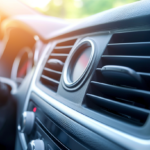Last Updated on 17 August 2023 by Lucas
Are you noticing a musty smell or reduced airflow in your car’s cabin? It might be time to change your car’s cabin air filter. In this article, we’ll guide you through the step-by-step process of changing the cabin air filter in your vehicle. By following these simple instructions and regularly maintaining your cabin air filter, you can enjoy cleaner air and better ventilation while driving. So let’s get started on improving the air quality inside your car!
Understand the Importance of a Clean Cabin Air Filter
You need to understand the importance of keeping your car’s cabin air filter clean. Regular maintenance of your cabin air filter brings several benefits. Firstly, it ensures that the air you breathe inside your car is clean and free from harmful pollutants. A clean cabin air filter also helps improve the performance of your car’s heating, ventilation, and air conditioning system by allowing proper airflow. It prevents dust, pollen, and other contaminants from entering the system, which can cause damage and decrease its efficiency over time.
To determine if your cabin air filter needs to be replaced, there are a few signs to look out for. If you notice reduced airflow through the vents or a musty odour when using the HVAC system, these could indicate a clogged or dirty cabin air filter. Additionally, if you frequently drive in dusty areas or have pets in your car, it is recommended to replace the filter more often as it can become dirtier quickly. By understanding these signs and regularly maintaining your cabin air filter, you can ensure cleaner and healthier air inside your vehicle.
Locate the Cabin Air Filter in Your Car
First, find the exact location of the cabin air filter in your vehicle. Here are three common ways to access the cabin air filter in different car models:
-
Glove Box: In some cars, the cabin air filter is located behind the glove box. Open the glove box and remove any contents inside. Look for a small panel or latch that can be released to reveal the filter.
-
Engine Compartment: In other car models, you may need to access the cabin air filter from under the hood. Locate the rectangular plastic housing near the windshield on one side of the engine compartment. Remove any screws or clips holding it in place to expose the filter.
-
Underneath Dashboard: Some vehicles have their cabin air filters tucked underneath the dashboard on either passenger or driver’s side. You might need to remove a cover or panel to reach it.
To maintain a clean and efficient cabin air filter, remember these tips:
- Check and replace your cabin air filter regularly as recommended by your car’s manufacturer.
- Keep an eye out for signs of dirt, dust, or debris accumulation on your filter.
- Consider upgrading to a higher quality or specialised cabin air filter if you frequently drive in areas with poor air quality or allergies.
By following these tips and locating your car’s cabin air filter correctly, you can ensure fresh and clean airflow inside your vehicle for a healthier driving experience.
Gather the Necessary Tools and Materials
To gather all the necessary tools and materials, make sure you have a screwdriver, pliers, and a new filter. These are essential for changing your car’s cabin air filter. When choosing a cabin air filter, there are a few tips to keep in mind. First, check your car’s manual or consult with an expert to find the right size and type of filter for your specific make and model. Additionally, consider opting for a high-quality filter that offers superior filtration capabilities to ensure clean air circulation in your car’s cabin. Now that you have the tools and know what kind of filter to get, it’s important to be aware of common signs that indicate a dirty cabin air filter. These can include reduced airflow through the vents, unpleasant odours coming from the vents, or increased dust particles inside your vehicle. By keeping these tips in mind, you’ll be well-prepared to change your car’s cabin air filter effectively.
Remove the Old Cabin Air Filter
Once all the necessary tools and materials are gathered, it’s time to remove the old cabin air filter. Start by locating the cabin air filter housing, which is usually located behind the glove compartment or under the dashboard. Open the housing by removing any clips or screws that hold it in place. Carefully take out the old filter and inspect it for dirt, debris, and signs of wear. Remember to dispose of the old filter properly.
Now that you’ve removed the old filter, it’s time to install a new one. Insert the new filter into the housing, making sure it fits securely and aligns with any arrows or markings on the filter itself. Close up the housing by reattaching any clips or screws you removed earlier.
Changing your car’s cabin air filter has numerous benefits. A clean filter improves air quality inside your vehicle by trapping dust, pollen, and other allergens. It also helps maintain proper airflow for heating and cooling systems, ensuring maximum efficiency. Regularly changing your cabin air filter can prolong its lifespan and prevent costly repairs down the line.
Clean the Housing and Surrounding Area
To properly maintain your vehicle’s air filtration system, it is important to regularly clean the housing and surrounding area. Here are four cleaning techniques you can use to ensure a thorough cleaning process:
- Start by vacuuming the area around the cabin air filter housing to remove any loose debris or dirt.
- Use a mild detergent mixed with water to wipe down the housing from both inside and outside.
- Pay special attention to the corners and edges where dust and dirt tend to accumulate.
- Allow the housing to dry completely before reinstalling the new cabin air filter.
Cleaning the housing not only helps remove common contaminants like dust, pollen, and debris but also ensures proper airflow through the filter. By following these simple steps, you can improve your car’s cabin air quality and prolong the life of your new cabin air filter.
Install the New Cabin Air Filter
After cleaning the housing and surrounding area, it’s time to install the new filter. Make sure you avoid common mistakes when installing a cabin air filter. First, double-check that the filter is facing the right direction by following the arrows or instructions on the packaging. Next, ensure that the filter is securely placed in the correct position within the housing. It should fit snugly without any gaps or misalignment. Lastly, don’t forget to close and secure any latches or clips that hold the housing together.
Using a high-quality cabin air filter comes with several benefits. It helps improve indoor air quality by trapping dust, pollen, and other airborne particles before they enter your car’s cabin. This can be especially beneficial for those with allergies or respiratory issues. Additionally, a good quality filter can help prolong your car’s HVAC system’s lifespan by preventing debris from clogging up vital components. Remember to change your cabin air filter regularly according to your vehicle manufacturer’s recommendations for optimal performance and air quality inside your car.
Reassemble the Housing and Secure the Filter
Now that you’ve cleaned the housing and installed the new filter, it’s time to reassemble the housing and ensure the filter is securely in place. Start by carefully aligning the tabs on both sides of the housing and gently pushing them together until they snap into place. Make sure all edges are flush and there are no gaps. Next, locate any screws or clips that were removed during disassembly and use them to secure the housing back together. Double-check that each screw is tightened properly to prevent any air leaks. Once you have reassembled the housing, give it a firm tug to ensure it is securely attached. Finally, turn on your car’s ventilation system to test if everything is working correctly. Following these steps will guarantee a successful reassembly of your cabin air filter housing with a securely installed filter.
Test the Airflow and Smell in Your Car’s Cabin
Check the airflow and smell in your vehicle’s cabin to ensure proper ventilation. This step is crucial to make sure that the new cabin air filter is working effectively. Here are some things you should do to test the airflow and check for any obstructions:
- Turn on the fan and adjust it to different speeds. Feel the air coming out of the vents to see if there is a strong flow or if it feels weak.
- Pay attention to any unusual smells, such as musty or mouldy odours, which could indicate a problem with the filter.
- Use your hand or a flashlight to inspect the area around the filter housing for any debris or blockages.
- If you notice reduced airflow or strange smells even after changing the filter, it might be worth getting your car’s HVAC system inspected by a professional.
By performing these tests, you can ensure that your car’s cabin air filter is doing its job properly and keeping you and your passengers breathing clean and fresh air.
Dispose of the Old Cabin Air Filter Properly
Make sure to properly dispose of the old filter once you have replaced it. Proper disposal is important to minimise the environmental impact. Start by checking with your local waste management facility or auto parts store for instructions on how to safely dispose of the old cabin air filter. Some cities offer recycling programs specifically for automotive filters, so take advantage of those if available. Avoid throwing the used filter in the regular trash as it can end up in landfills and potentially harm the environment. Additionally, be careful when handling the old filter as it may contain dirt, dust, and other contaminants that can be harmful if released into the air or water. By disposing of your old cabin air filter correctly, you are doing your part to protect both your car’s performance and the environment.
Schedule Regular Maintenance for Your Cabin Air Filter
It’s important to regularly maintain your vehicle’s cabin air filter. By scheduling regular maintenance for your cabin air filter, you can ensure that it continues to function effectively and provide clean air for you and your passengers. Regular maintenance not only helps keep the air inside your car fresh and free from pollutants, but it also has benefits for other car components. A dirty cabin air filter can affect the performance of your HVAC system, causing it to work harder and potentially leading to costly repairs. Additionally, a clogged filter can decrease airflow, resulting in reduced cooling or heating efficiency. Common signs of a dirty cabin air filter include reduced airflow from the vents, unpleasant odours, and increased dust accumulation in the interior. So be sure to stay on top of regular maintenance to keep your cabin air filter working optimally and improve overall air quality in your vehicle.

Lucas is an experienced vehicle technician with hands-on knowledge of almost every car brand available. Throughout his career, Lucas has worked on a wide range of vehicles, including domestic and foreign models, sports cars, trucks, and SUVs.




